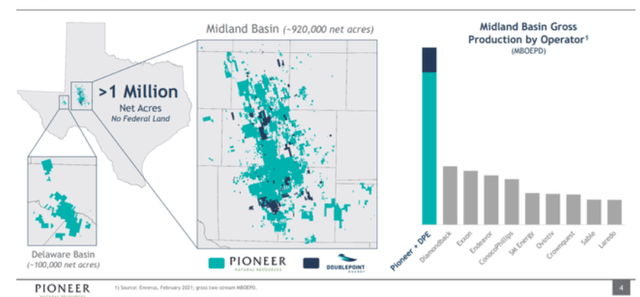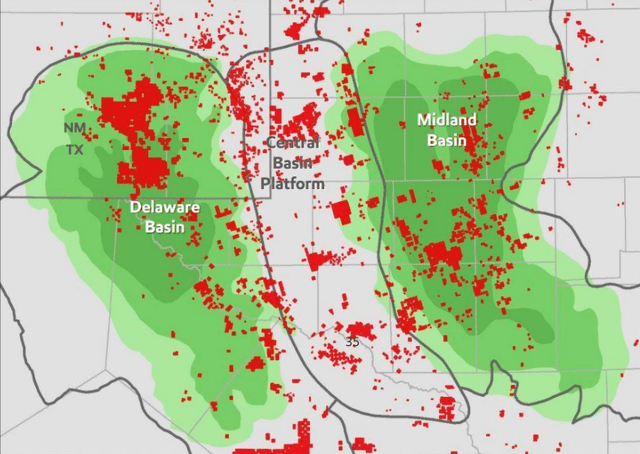Summary:
- The Permian has gas. Gas is cheap, and XOM already has plenty of gas thank you very much from the XTO and BOPCO deals.
- PXD has the best oil-weighted block of acreage in the Permian, and oil is getting more expensive.
- XOM wants oil for a lot of reasons. We think the two companies will do a deal.
- We maintain our sell rating on XOM stock.
You seeing a problem here, sport? Your socks are looking mighty tasty I might add. Feed me Seymour! Zontica/iStock via Getty Images
Introduction
There’s been a flurry of articles on Exxon Mobil (NYSE:XOM) recently, one of which was my recent discussion of why I rated XOM a sell at current pricing. I riled up a few folks with that take, if the tone of some of the commentary was any guide. Some of whom might have quit reading in disgust, clicked the back-arrow key, and missed the part where I said, I’d be a buyer at a discount. Settle doon lads, I’ma gonna cheer ya up with this one. (I am entitled to affect the Scottish brogue by virtue of having lived in Aberdeen in the early 90s.)
The Wall Street Journal reported April 7th that Exxon Mobil and Pioneer Natural Resources (PXD) were in preliminary discussions about a merger. It’s been pretty quiet since, but it’s only been a week and I am sure there’s a good bit of haggling to be done on the sell-side.
Nonetheless, I am convinced this deal will get done as there are a number of drivers for it, that no other combination will bring, contrary to some suggestions I’ve heard. And, in the final analysis XOM must feed the beast, and PXD would be a tasty morsel.
The Midland basin has its Quinceanera
There has been a good bit of M&A activity the last year or so in shale country. Quite a bit of which was in the Eagle Ford play in South Texas. Devon Energy (DVN), Marathon Oil (MRO), and recently, Baytex Energy (BTE) have made bold moves in the Eagle Ford, breathing new life into that play.
Now it appears, just as the liquids-rich Midland basin has its fifteenth anniversary of the advent of horizontal shale fracking, this sub-basin of the massive Permian basin is drawing the acquisitive eye of companies looking to bulk up their acreage footprint. There have been some smaller deals focusing on the Midland basin over the last six months. Examples would be Diamondback Energy’s (FANG) pick up of Firebird Energy last fall and early this year, a buyout of Lario Oil and Gas’ interests in the Permian.
Come early April, it was clear that the late 2022 lull in M&A activity was coming to an end when the news broke last week that a megadeal might be in the works for the Midland basin’s, and indeed the entire Permian basin’s largest producer, Pioneer Natural Resources.
In this article, we will discuss some of the key drivers behind what will be the largest oil company merger since Occidental Petroleum (OXY) bought Anadarko Petroleum in 2019. If it comes together, of course. Incidentally, if you want to read an article that seemed to have really poor timing when it was published, but the thesis of which has been validated in the fullness of time, go back and read my initial take on the OXY/Anadarko deal, OXY: Playing The Long Game In The Permian. The thesis for XOM is similar to what OXY saw in Anadarko; forget everything else, it’s about the rock.
The building of a shale giant
Pioneer Natural Resources was born in a 1997 merger between a firm formed by two West Texas Wildcatters, Howard Parker and Joe Parsley with Boone Pickens flagship oil company, Mesa Inc. In 2020, PXD agreed to acquire Parsley Energy, a company formed in 2008 by Bryan Sheffield, son of Scott Sheffield, CEO of PXD in a $7 bn transaction. The deal added about 300,000 acres to PXD’s core Midland basin position and about another 100,000 acres in the Delaware basin.
Then, in 2021, PXD shelled out another $6.4 bn to buy privately held DoublePoint Energy for its bolt-on acreage in the heart of the Midland basin. As you can see from the slide below, PXD emerged from this deal with nearly a million acres of very contiguous, blocky acreage that propelled them to the top of pack of Permian producers.
PXD Midland basin footprint (PXD)
It is this core position that optimizes logistics, including drilling wells with 12-15,000’ lateral legs. In a recent analyst conference call, CEO Sheffield spoke to the importance of these long laterals.
“The contiguous nature of our acreage position provides multiple operational benefits including drilling and completing 15,000-plus foot laterals with greater than 100 of these expected to be placed on production in 2023. These longer laterals “drive improved returns and higher productivity.”
If you are looking for a site for a “well factory,” it doesn’t get any better than PXD’s nearly one million acre footprint in Texas’ Upton, Midland, and Martin counties. Additionally this acreage yields oil-weighted production at a time when it’s clear the demand/supply curve for this commodity is shifting toward a deficit later this year.
Against this backdrop incorporating PXD’s assets into its massive Permian footprint is a compelling prospect for XOM. What remains to be seen is if Scott Sheffield and Darren Woods can come to a “gentleman’s agreement,” and stave off other suitors who must be considering a challenge for PXD. None of these companies could challenge XOM directly, but might appeal as merger candidates to PXD, if XOM won’t come to terms. I am thinking primarily of Diamondback Energy which has made incremental moves in the Midland basin recently. Perhaps they see the writing on the wall and know the future in shale is grow, or die.
Exxon Mobil’s conundrum
Exxon Mobil in West Texas is also a creation of multiple significant acquisitions beginning in 2009 with gas juggernaut, XTO Energy, for $41 bn in cash and stock. The timing of this purchase was off as gas prices struggled in the 2010’s, leading to the oil giant taking a massive write down on the purchase in 2020.
XOM doubled-down on the Permian with its 2017 purchase of Bass family holdings, better known as BOPCO. This time the quest was to increase liquids (crude oil and condensate) production, as newly appointed XOM CEO Darren Woods noted in the announcement–
“This investment gives us an exceptional Delaware Basin position in a proven multi-stacked play that can generate attractive returns in a low-price environment. The highly-contiguous position will provide significant cost advantages in developing 3.4 billion barrels of resource, of which 75 percent is liquids. By utilizing ExxonMobil’s technological strength coupled with its unconventional development capabilities we can drill the longest lateral wells in the Permian Basin, reducing development costs and increasing reserve capture.”
ExxonMobil’s Permian acreage footprint (XOM)
Discerning readers will note the similarity in the language used by these two CEO’s as they described the advantages that would come from combining their companies with the companies being acquired at the time.
Scale, Logistics, Lower Cost, Technology and longer laterals are common to each CEO’s pitch as what their respective deals would bring to the parent company. I discussed these attributes in an article on ConocoPhillips (COP), shortly after its ~$10 bn buyout of Shell’s (SHEL) Delaware position in 2021.
It is now necessary to compare each company’s acreage footprint to fully understand Exxon Mobil’s conundrum – how to grow efficiently in the Midland basin, and obtain those longer laterals throughout their widely scattered, but sizeable acreage position in the basin. When you do that XOM’s desire for PXD becomes obvious.
Exxon Mobil and the Law of Large Numbers
The company has made no secret of its intention to grow Permian production to a million barrels equivalent per day by 2027. At today’s current level of ~600K, that requires a 12% CAGR and gets you comfortably through that million on schedule. To get there they have to replace ~128K BOEPD of decline and add about ~80K BOEPD of new production in 2023, and incrementally more in the next few years. Then the Law of Large Numbers really kicks in.
For 2023 XOM will need to drill several hundred wells in the Permian to stay on track with this target. They have about $4 bn budgeted for the Permian this year, and that should deliver about the 350 or so wells, figuring $10-12 mm per well needed to hit the target for 2023.
What about 2024? 2025, and so on? The capex required will be higher each year, probably another half a billion, and the results may be elusive, as the best locations get drilled and the production curve begins to flatten. I discussed the problem of the quality in remaining shale acreage in an article back in February, “The State of Play in Shale.” Readers desiring more color on this topic should definitely give this a read.
Exxon Mobil will probably hit its target in 2027. They are really good at big project development, as I noted in the dedicated XOM article recently. Given their deep pocketbook and their ability to attract resources, they’ve got a good shot at it. But, why wait? It will only get more expensive and they might hit a resource wall – there’s only so many pad walking drilling rigs available, as an example. They can get to a million BOEPD and more this year and all it takes is money, and the two CEOs making a deal.
Your takeaway
Using conventional metrics PXD is fairly valued at 5X EV/EBITDA and ~$80K per flowing barrel. To go beyond that you have to factor in XOM’s need for growth – PXD would double their output to ~1.3 mm BOEPD, and their need to operate their Midland basin acreage in the most efficient manner possible. XOM will have to put a factor on what the value of PXD’s ~$11 bn of TTM EBITDA, their 600,000 BOEPD of liquids weighted production, and 2.2 bn bbls of 2P production are worth. We may be surprised at what they come up with.
Hopefully they won’t take too long, PXD shareholders are expecting a nice “payday” bump from current share pricing, and counting on Mr. Sheffield to drive a hard bargain. With his more than 568K share position in the company, they don’t have much to worry about.
What will XOM pay? Analysts are valuing PXD between $210 and $380 per share. $210’s obviously out of the window. What would it take to get to $380? PXD threw off $6bn in Free Cash equivalent for Q-3, 2022. Fun With Numbers says if we extend this rate of cash flow for 10 years and add 5% CAGR, we can get to $85 bn FCF. At their current float of 256 mm, that works out to $332 per share. That guy/gal with the $380 forecast must have gone to the same Fun With Numbers school I did, only he/she got better grades. That’s why they are a million dollar a year analyst, and I ended up checking mud for 40 years. (I probably have better snake stories though.)
This story has a happy ending for holders of PXD in my view. Holders of XOM might see debt balloon higher. Hence our sell rating at current prices.
We don’t have anything official yet, but there is too much synergy in this transaction for it not to go through eventually, in my estimation. I doubt we have long to wait.
Analyst’s Disclosure: I/we have no stock, option or similar derivative position in any of the companies mentioned, and no plans to initiate any such positions within the next 72 hours. I wrote this article myself, and it expresses my own opinions. I am not receiving compensation for it (other than from Seeking Alpha). I have no business relationship with any company whose stock is mentioned in this article.
This is not advice to buy or sell this stock or ETF in spite of the particular rating I am forced to select in the SA template. I am not an accountant or CPA or CFA. This article is intended to provide information to interested parties and is in no way a recommendation to buy or sell the securities mentioned. As I have no knowledge of individual investor circumstances, goals, and/or portfolio concentration or diversification, readers are expected to do their own due diligence before investing their hard-earned cash.
Seeking Alpha’s Disclosure: Past performance is no guarantee of future results. No recommendation or advice is being given as to whether any investment is suitable for a particular investor. Any views or opinions expressed above may not reflect those of Seeking Alpha as a whole. Seeking Alpha is not a licensed securities dealer, broker or US investment adviser or investment bank. Our analysts are third party authors that include both professional investors and individual investors who may not be licensed or certified by any institute or regulatory body.

